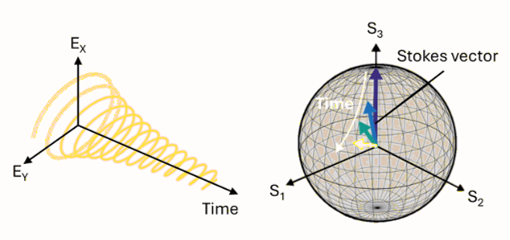The design and study of molecules capable of emitting circularly polarized light (CPL) represent a crucial research field for the development of new technologies. Applications range from securing optical communications to developing more energy-efficient displays and holographic systems. To improve our understanding of the relationship between the structure and properties of these materials, it is essential to measure the evolution of light polarization over time. Until now, however, available analytical methods (spectrometers) required a compromise between speed, sensitivity, and spectral range.
FROM EPFL…
Recently, Professor Feldmann's team at EPFL developed a spectroscopy device that combines all three features. This approach makes it possible to capture the full set of polarization states (Stokes vector) across a wide spectral window (400–900 nanometers) and over time intervals ranging from a few nanoseconds to several milliseconds, with high sensitivity.

Stokes vector representation © Marcel Mattes /EPFL
…TO SCBM
To test the performance and potential limitations of their new device, EPFL researchers collaborated with the team of Grégory Pieters (SCBM), which had carried out pioneering work in the design and characterization, using conventional chiral spectroscopic methods, of purely organic molecules that emit both circularly polarized light and delayed fluorescence (see Joliot news). Thus, the chiral organic materials synthesized by the SCBM team served as molecular model systems to test the performance of the new analytical approach developed at EPFL. Overall, the measurements revealed unprecedented dynamics in these complex molecular systems, where CPL emission occurs on both fast (ns) and slow (µs to ms) timescales.
This study paves the way for improving the performance of polarized light-emitting materials and will contribute to the development of next-generation high-performance optical systems by revealing their underlying dynamics with unprecedented detail.
See also the EPFL news :
https://actu.epfl.ch/news/new-technique-captures-every-twist-of-polarized-li/
Joliot contact : Grégory Pieters (gregory.pieters@cea.fr)
Circularly polarized luminescence (CPL) is a specific type of light emission produced in particular by chiral molecular materials, where light waves propagate in either a left- or right-handed spiral.